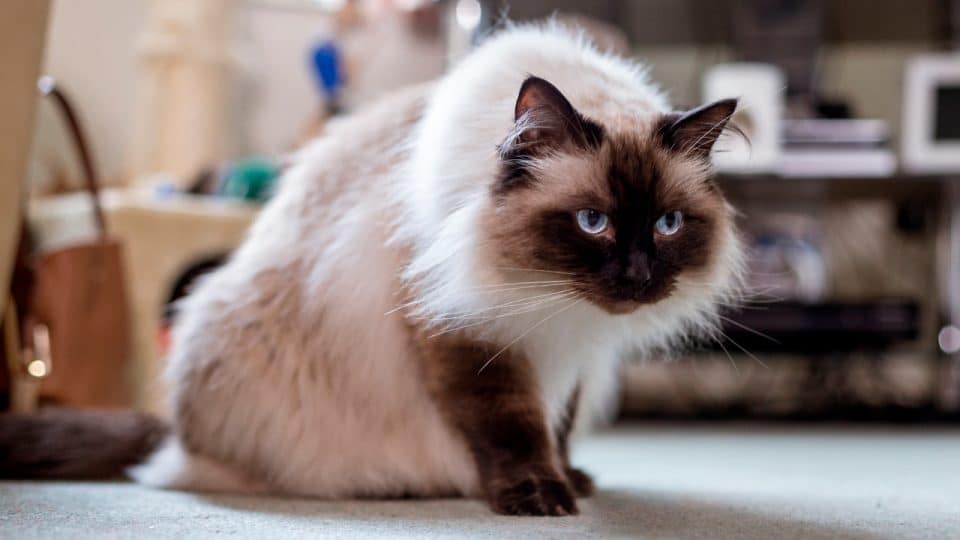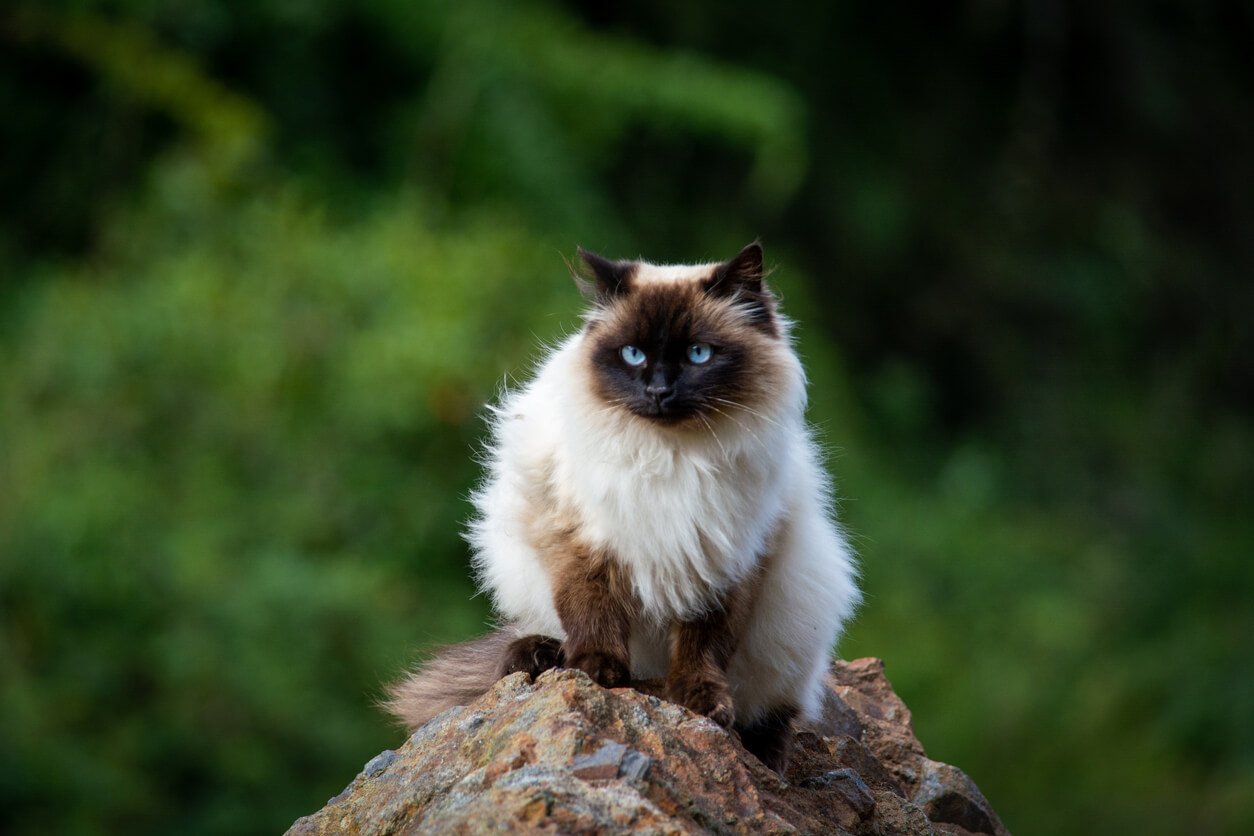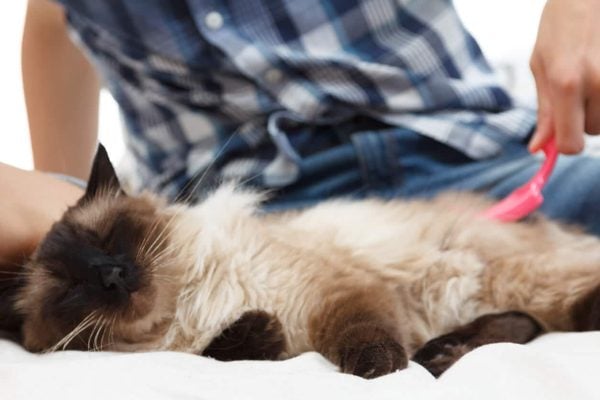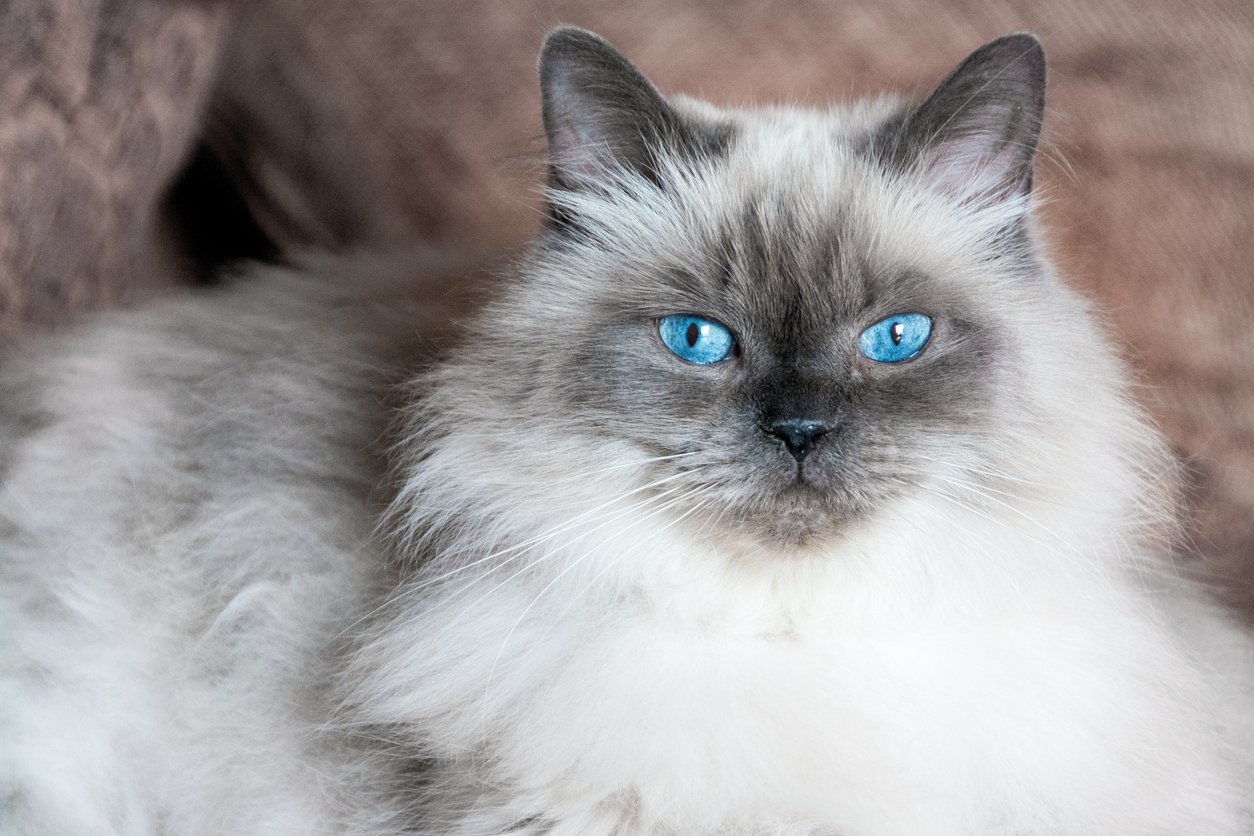- Not a substitute for professional veterinary help.
Himalayan cats have striking blue eyes and luxurious, fluffy fur. Many people consider them the picture of elegance—but they’re popular for more than their appearance! Their affectionate and social personalities also make them excellent companions.
Lap cats at heart, Himalayan cats make a great fit for families with children. Their easygoing temperaments also means they do well in multi-cat homes.
Interested in welcoming a Himalayan cat into your home? Read on to learn more about the breed, including their grooming needs, personality, health concerns, and other key traits.
Himalayan Breed Overview
- Origin: United States
- Weight: 7-15 pounds
- Size: Medium
- Coat length: Long, double coat
- Coat color: White, cream, or fawn with darker “point” markings
- Coat patterns: Seal point, lynx point
- Eye color: Blue
- Grooming: High
- Shedding: Year-round
- Lifespan: 8-18 years
- Hypoallergenic? No
- Activity level: Medium
- Meowing and vocalization: Low
- Good with other cats: Yes
- Good with kids: Yes
- Good with dogs: Yes
Himalayan cats were first bred in the U.S. They came about as an attempt to cross the Siamese and Persian cat breeds.
The resulting kittens resembled Siamese cats very closely instead of having an equal mix of traits. Because of this, the breeder decided the experiment was a failure.
In the 1950s, another set of breeders followed in their footsteps and developed the Himalayan cats we know today. These cats have Persian builds and Siamese coloration.
The Cat Fancier’s Association accepted the Himalayan as a breed in 1957. In 1985, however, the breed was reclassified as a color variation of the Persian breed.
Some breed organizations continue to acknowledge the Himalayan as a distinct breed, says Hope Gonano, a show-quality Himalayan cat breeder and owner of Laureden Cattery. But the Cat Fancier’s Association still considers Himalayan cats a variant of the Persian breed.
In other parts of the world, Himalayans are even known as Colorpoint Persians. This definition refers to the Siamese-like “point” coloration on Himalayans, Gonano says. The darker fur on their face, ears, paw, and tail contrasts with lighter fur on the rest of their body.
What Do Himalayan Cats Look Like?
You might picture a Himalayan cat with a Siamese-like beige body and a dark chocolate face, ears, paw, and tail. But these cats can come in many more colors and patterns, Gonano says.
Himlayans generally have a light base coat in creamy white or fawn. Some Himalayans will have milk chocolate or lavender gray tones in their fur, but this is less common. All Himalayans have the same hair type: a long-haired double coat that sheds all year.
This breed has two recognized coat patterns, Gonano says: seal point and lynx point.
- Seal point: This pattern has “points” of fur that are darker than the base coat and concentrated on the cat’s face, ears, paws, and tail.
- Lynx point: This pattern has “points” of tabby markings that are darker than the cat’s base coat and concentrated on their head, face, legs, and tail.
Seal point or lynx point markings can come in several colors, including dark brown, blue, flame, cream, chocolate, lilac, and tortoiseshell.
All Himalayan cats also have blue eyes, Gonano says.
What Kind of Personality Do Himalayan Cats Have?
Himalayans are known for their gentle, loving, and loyal personalities. As a calmer, lower-energy breed of cat, they’re more drawn to cuddles and naps on their favorite person’s lap than counter surfing, curtain climbing, and zoomies.
“Himalayans are super sweet companions. They like to play and are good pets for anyone,” Gonano says.
They get along well with kids, other cats, and other pets. They’re also less likely to have behavioral concerns like excessive vocalizations, biting, or destructive scratching.
Himalayans are also less interested in climbing and exploring high places than some other cat breeds, like Bengals—in part because they have shorter legs that make it difficult for them to jump very high!
While Himalayan cats may not need constant entertainment, they still benefit from daily enrichment, including mental and physical activity.
They make a good fit for first-time cat parents—as long as you can make their grooming needs a priority!
The ideal pet parent for a Himalayan cat will:
- Groom them daily
- Stay on top of vet visits
- Provide plenty of cuddling sessions
- Offer quiet enrichment, like window seats and puzzle toys
Grooming a Himalayan Cat
Himalayan cats aren’t effortlessly gorgeous. Their magnificent coats call for a serious commitment. These cats require daily grooming attention, from brushing to cleaning tear stains and eye discharge deposits on their face.
Important: Gonano says a Himalayan’s grooming needs are one of the most important things to consider before adopting or buying one. This breed needs a high level of daily physical care.
Grooming at home
Long-haired cats like Himalayans benefit from monthly baths and daily brushing to combat heavy shedding and prevent issues like tangles and mats, says Christiana Spurlock, a Certified Feline Master Groomer and owner of Classy Claws Mobile Grooming.
Their relaxed personalities mean you can generally handle them pretty easily during grooming time, especially if you introduce them to grooming tools when they’re kittens.
Spurlock advises using a metal face-feet finishing comb and metal carding cord to focus on high-friction areas like the belly, armpits, and between the cat’s back legs, while using a metal face-feet finishing comb and a metal carding cord.
“I don’t love the Furminator brushes as they can be easily misused and can pull out hair that’s not ready to shed,” Spurlock says.
Since Himalayans tend to be lap cats, they can do well with lap brushing. To brush the belly, you can lift their front end with one hand and hold them gently with their back against your chest.
Professional grooming
Beyond daily brushing, Himalayans should visit a professional groomer for sanitary trims several times a year.
Sanitary trims, also called hygiene cuts, help prevent feces and urine from getting stuck in a cat’s hair. This specialized type of grooming needs a steady professional hand, along with specific razors that target the hair under a cat’s tail near their genitals, anus, and down their back legs.
In short, you won’t want to try giving your cat a sanitary trim at home. The genital area is very delicate, and accidental injuries can cause a lot of pain—and potentially a serious infection.
Facial cleaning
Due to their flat faces, Himalayan cats also need regular attention and cleaning around their eyes and nose.
This brachycephalic breed has a shortened skull structure, so even healthy cats may experience eye drainage problems, like excessive tearing and discharge. You’ll need to gently wipe the area daily or weekly, as needed and recommended by your vet.
Breeders, vets, and professional groomers can give you more guidance on cleaning your cat’s face.
Just keep in mind that you’ll want to choose products specifically made for cats and always avoid alcohol-based cleaners—these are toxic to cats, Spurlock says.
Himalayan Health Concerns
Since Himalayan cats are a variant of Persians, they may develop some of the same health issues, especially genetic concerns and health problems related to their exaggerated facial structure.
Before you purchase a Himalayan cat from a breeder, ask them about any genetic testing done on the kitten’s parents and if the cat’s line has any health issues. The most ethical and reputable breeders will do genetic and health testing on parent cats and share this information with prospective cat parents.
Some health issues common among Himalayan cats include:
-
- Tear duct and nasal cavity disorders: Epiphora, a condition unique to flat-faced breeds, involves a chronic overflow of tears, eye discharge, tear staining, and blocked nasal ducts. You can generally manage this condition by routinely cleaning the cat’s face. In some cases your vet may recommend surgery, which has a high success rate.
- Feline asthma: This inherited health issue affects the respiratory system and lungs. Feline asthma attacks resemble human asthma attacks. Allergens trigger the airways to become inflamed, swell, and constrict, which causes difficulty breathing. Treatment might include medication like corticosteroids and allergy desensitization.
- Feline infectious peritonitis (FIP): Purebred Himalayan cats may be more likely to develop this highly infectious viral disease. It’s caused by strains of feline coronavirus and involves symptoms like diarrhea and difficulty breathing. The virus can eventually mutate and migrate to a cat’s abdomen, kidney, or brain. Antiviral medications can help treat this condition.
- Ehlers–Danlos syndrome: This connective tissue disorder develops from a genetic defect in collagen production. Himalayan cats with EDS have fragile skin that’s prone to bruising, slow wound healing, scarring, loose joints, blood pooling under their skin, and fluid-filled cysts.
- Polycycstic kidney disease: This genetic disease mostly affects Himalayan and Persian cats. Cats with PKD have cysts in their kidneys from birth. These cysts grow over time and can eventually lead to fatal kidney failure.
- Basal cell tumors: Domestic long-haired cats like Himalayans can also develop basal skin tumors. These dark, hairless lumps can appear anywhere on the body, on the top layer of the skin. They’re mostly benign and non-cancerous, but sometimes they’ll rapidly grow, causing inflammation and ulcers. If this happens, your vet may recommend surgical removal.
Diet and nutrition
Himalayan cats with health concerns might benefit from specialized diets.
For instance, Himalayan cats with PKD or other kidney problems might need to follow a low-phosphorous diet to slow the progression of their disease.
What’s more, Persian and Himalayan cats have higher rates of dental diseases than other breeds. Choosing wet and dry foods that help target plaque and tartar buildup can improve your cat’s dental health.
It’s also important to work with your vet to help your cat stay at a healthy weight. They may recommend a lower calorie cat food or switching to wet food.
Important: Ask your vet before you change your cat’s food or give them smaller meals. It’s important to make sure your cat gets enough nutrients, and your vet can recommend the right serving size to help them stay healthy.
How to Get a Himalayan Cat
If you’ve decided on a Himalayan, you can try searching for a purebred or mixed breed cat from a breed-specific rescue or an animal shelter or buy a Himalayan kitten from an ethical breeder.
Buying a Himalayan cat
Gonano says one green flag in Himalayan breeders is honesty about the care these cats need, especially when it comes to grooming.
Buying from a show breeder can be a good choice with Himalayans. Show breeders prioritize producing cats that conform to breed standards. They’ll also do regular genetic and health testing of parent cats.
Before choosing to purchase from a breeder, you’ll want to make sure of a few other important things:
- The kitten is at least 12 weeks old.
- They’ve had their first shots and been tested for feline immunodeficiency virus (FIV) and feline leukemia (FLV).
- The breeder is willing to show you where the kittens and mother cat sleep.
- The breeder shares health information about the cat’s parents and genetic history.
The best Himalayan cat breeders will also have:
- USDA certifications
- Buyer protection contracts for genetic defects in their cats and kittens
- Accreditation from the Better Business Bureau (BBB)
- Strong social proof about their quality and credibility across websites and apps like Google Reviews, Facebook, Yelp, and Reddit
Adopting a Himalayan Cat
When adopting a Himalayan cat, Gonano says to make sure they have a healthy appearance. This might mean the cat has an open expression, open nostrils, and a face without tear staining and eye discharge.
Alternative Breeds
Not sure you have the time to dedicate to a Himalayan’s grooming routine, but still want an easygoing and cuddly feline friend? Consider one of these other fluffy, family-friendly, and social cat breeds.
- British Longhair
- Exotic Shorthair
- Ragdoll
- Tonkinese
- Snowshoe
- Japanese Bobtail
- Turkish Van
- Ragamuffin






